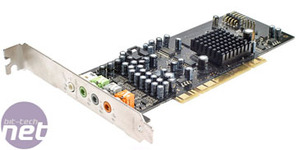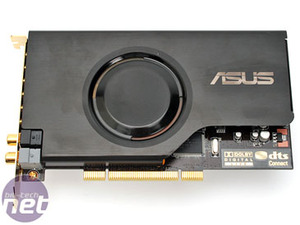
Sounding yourself out...
Of course paying all sorts of attention to your speakers isn’t going to do a whole lot of good if you’re using on-board AC97 audio. The sound card, like the speakers, is an area where you have to decide where your priorities lie. If you’re a heavy gamer then you may decide you need the latest version of EAX and multi channel support, if you watch the occasional film and play a few games, you may want multi channel but not need EAX.As with the speakers, the best solution for a pure music setup is stereo, this means a two channel card sacrificing all of the bells and whistles on gaming cards and other multi-channel cards. If you’re just in to music, this isn’t going to be a problem, but if you intend on gaming and watching films as well, then you may have to compromise the overall sound quality for the sake of extra features.
Sound cards generally can be slotted into one of three categories: on-board, gaming and professional. While this is a bit of a quick and dirty way of looking at it, feature sets and sound quality are usually pretty similar across the board for a single group. On-board audio is usually as basic as it gets in terms of both sound quality and features.
Despite the fact that many motherboard manufacturers are starting to take audio more seriously on their high-end boards, the integrated nature of the circuitry and cost constraints mean that generally on-board audio will give you the lowest sound quality of all three categories. If you’re after high quality sound, then on-board audio is unlikely to satisfy, and you may want to sacrifice some of your hard-earned cash for an add-in card instead of going with the “free” sound on the motherboard.

Going for an add-in card leaves you with two very distinct options – a gaming card or a professional card. The vast majority of sound cards in enthusiast systems today are, unsurprisingly, gaming cards. These cards can offer a big improvement in sound quality over on-board audio along with a whole host of features for gaming, films and music playback. The cards range from the cards like the modestly priced basic Creative X-Fi to the considerably more expensive cards like the Razer AC-1 and Asus Xonar D2.
The feature sets between these cards differs only slightly, your money is usually going towards the use of higher quality components on the card.
 Using higher quality capacitors, op-amps and DACs on a card are a step in the right direction for sound quality, but aren’t necessarily the final word. For instance, the Asus card will set you back around £120/$180, but still utilises the same basic underlying audio chipset that is found in many budget add-in cards costing a fraction of the price. As is the case when buying any component, make sure you’ve read up before buying and don’t just immediately fall for marketing bling.
Using higher quality capacitors, op-amps and DACs on a card are a step in the right direction for sound quality, but aren’t necessarily the final word. For instance, the Asus card will set you back around £120/$180, but still utilises the same basic underlying audio chipset that is found in many budget add-in cards costing a fraction of the price. As is the case when buying any component, make sure you’ve read up before buying and don’t just immediately fall for marketing bling.As you may have guessed, the professional cards tend to be the best for all out music fidelity, but you have to make some compromises where features are concerned. This usually means sacrificing any form of EAX, surround sound, any Dolby or DTS encoding and any clever gaming or movie “modes” that you get on many other cards. Many of these cards do introduce a whole bunch of new features, but you’re unlikely to use any of them unless you’re an audio creation professional. When you buy one of these cards, your money is being spent high quality components coupled with an audio chipset focussed on audio fidelity, as opposed to gaming features.
Entry level professional cards are generally the most sensible options for music playback, not only because they’re reasonably priced, but also because the high end (and far more expensive) cards often offer the same sound quality and the cost is justified only by features and added I/O that you’re unlikely to use. E-Mu and M-Audio are notable makers of professional cards, the E-Mu 0404 being a very popular choice amongst PC audio enthusiasts. To buy these sound cards, you will probably have to venture from the safety of your usual computer component retailer and have a look at pro audio shops. The term “professional” makes these cards sound expensive, but prices of entry-level pro cards are comparable to those of gaming cards.

There is of course a way to get both the superior sound quality of pro cards and all of the shiny features that come with the gaming cards and it's simpler than one may expect - use two cards. Windows is relatively hassle-free when it comes to using multiple sound cards. At most, you will have to change the default audio device and do some cable swapping, but depending on your listening habits, you may not have to do anything at all to swap over.
For example, for music, I use an E-Mu 1212m connected to speakers. This card is assigned as the default output in Foobar, whereas a Creative X-Fi is assigned as the default windows audio device. The X-Fi is connected to headphones for gaming duties and general purpose sound. If you want to use the same speakers for both cards, however, you will need to perform some degree of cable swapping unless your speakers can receive more than one output.
A different route you can take to get better quality out of a gaming card (or even a pro card) is to use an external DAC or resort to attacking it with a soldering iron. The latter option isn’t the simplest of tasks, but a with a steady hand, a fine tipped soldering iron and a play-by-play guide it’s a lot easier than it sounds. The most common modifications are op-amp swaps and capacitor upgrades and you can usually find pretty comprehensive guides for the more popular cards scattered around the Internet. Using an external DAC can give quite a noticeable improvement in sound quality as not only is it usually of higher quality than the integrated DAC on the sound card, but because it also isolates the DAC from interference inside the case.
Final Thoughts...
So we’ve looked at some no-cost routes for maximising audio performance and how to progress from there if you’re not against spending some money. Even if you don’t fancy yourself as an audiophile, it's worth trying out some of the no-cost tweaks, as better sound can never be a bad thing, can it?. If you were unsatisfied with the sound you were getting from your PC and looking to upgrade components, but didn’t know where to start, hopefully you now have a firm starting point from which to progress.While upgrading and tweaking your system can be enjoyable and rewarding, it’s good to keep in mind that it shouldn’t be all about the sound, but about the music. The pursuit of sound perfection is in vain if you end up analysing the sound so much that you aren’t really listening to the music any more. It’s all too easy to get caught up in upgrading parts and lose sight of what you’re really trying to achieve.
Everyone is different and if you find that something doesn’t sound right to you, don’t do it. There’s no point wasting all of your hard drive space on FLAC if you genuinely can’t tell the difference between MP3 files that are a quarter the size. It’s perfectly plausible that you may replace your on-board audio with an add-in card and find that you can’t hear a difference, or you can hear a difference but not one that necessarily results in better sound. Audio is incredibly subjective and “better” can sound awfully different to one person than to another. The moral of the story: enjoy yourself and do what sounds best to you.

MSI MPG Velox 100R Chassis Review
October 14 2021 | 15:04








Want to comment? Please log in.